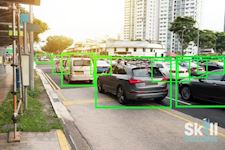Computer Vision: Python Optical Character Recognition And Object Detection
Skill Success
Summary
- Certificate of completion - Free
- Tutor is available to students
Overview
This course includes lifetime access so you can complete it at your own speed.
This course is designed for those interested to learn the basics of Optical Character Recognition with Tesseract Library, Image Recognition using Keras, Object Recognition using MobileNet SSD, Mask R-CNN, YOLO, and Tiny YOLO.
Benefits of taking this course include:
- Unlimited and lifetime access to the course
- Learn the course at your own pace
- Course can be accessed on any platform
- 24/7 Customer support
Course media
Description
Welcome to the third course from my Computer Vision series - Python Optical Character Recognition And Object Detection.
Image Recognition, Object Detection, Object Recognition and also Optical Character Recognition (OCR) are among the most used applications of Computer Vision.
These techniques enable computers to recognize and classify either a whole image or multiple objects inside a single image, predicting the class of the objects with the percentage accuracy score. Using OCR, computers can also recognize and convert texts in images to machine readable format like text or a document.
Object Detection and Object Recognition, on the other hand, are widely used not only in many simple applications but also complex ones like self driving cars.
This course will be a quick starter for people who want to dive into Optical Character Recognition, Image Recognition and Object Detection using Python without having to deal with all the complexities and mathematics associated with the typical Deep Learning process.
For those of you who may not be coming from a Python-based programming background, there are lectures which will help you get the basic Python programming skill to follow the course.
The code, images, and libraries used are included inside this course. You are free to use them in your projects with no questions asked.
Computer Vision: Python Optical Character Recognition And Object Detection will cover the following topics:
Section 1 - Introduction
- Course Introduction And Table of Contents
- Introduction To OCR Concepts
- Setting Up The Environment – Anaconda
- Downloadable Materials – Codes And Images
Section 2 - Python Basics
- Python Basics – Part 1 – Assignment
- Python Basics – Part 2 – Flow Control
- Python Basics – Part 3 – Data Structures
- Python Basics – Part 4 – Functions
Section 3 - Tesseract OCR Setup
- Tesseract OCR Setup – Part 1
- Tesseract OCR Setup – Part 2
- OpenCV Setup
- Tesseract Image OCR Implementation – Part 1
- Tesseract Image OCR Implementation – Part 2
- ImShow Not Responding Issue Fix
Section 4 - CNN - Convolutional Neural Networks
- Introduction To CNN – Convolutional Neural Networks
- Installing Additional Dependencies For CNN
- Introduction To VGGNet Architecture
- Image Recognition Using Pre-Trained VGGNet16 Model – Part 1
- Image Recognition Using Pre-Trained VGGNet16 Model – Part 2
- Image Recognition using Pre-Trained VGGNet19 Model
- Image Recognition using Pre-Trained ResNet Model
- Image Recognition using Pre-Trained Inception Model
- Image Recognition using Pre-Trained Xception Model
- Introduction to MobileNet-SSD Pretrained Model
- Mobilenet SSD Object Detection – Part 1
- Mobilenet SSD Object Detection – Part 2
- Mobilenet SSD Realtime
- Mobilenet SSD Video
- Mask RCNN Introduction
- MaskRCNN Box Implementation – Part 1
- MaskRCNN Box Implementation – Part 2
- MaskRCNN Mask Implementation – Part 1
- MaskRCNN Mask Implementation – Part 2
- MaskRCNN Realtime – Part 1
- MaskRCNN Realtime – Part 2
- MaskRCNN Video
- YOLO Introduction
- YOLO Implementation – Part 1
- YOLO Implementation – Part 2
- YOLO Realtime
- YOLO Video
- Tiny YOLO Video
- Tiny Yolo Realtime
Who is this course for?
This course is designed for those interested to learn the basics of Optical Character Recognition with Tesseract Library, Image Recognition using Keras, Object Recognition using MobileNet SSD, Mask R-CNN, YOLO, and Tiny YOLO.
Requirements
No prior knowledge is required to take this course.
Career path
None
Questions and answers
Currently there are no Q&As for this course. Be the first to ask a question.
Certificates
Certificate of completion
Digital certificate - Included
Reviews
Currently there are no reviews for this course. Be the first to leave a review.
Legal information
This course is advertised on reed.co.uk by the Course Provider, whose terms and conditions apply. Purchases are made directly from the Course Provider, and as such, content and materials are supplied by the Course Provider directly. Reed is acting as agent and not reseller in relation to this course. Reed's only responsibility is to facilitate your payment for the course. It is your responsibility to review and agree to the Course Provider's terms and conditions and satisfy yourself as to the suitability of the course you intend to purchase. Reed will not have any responsibility for the content of the course and/or associated materials.


